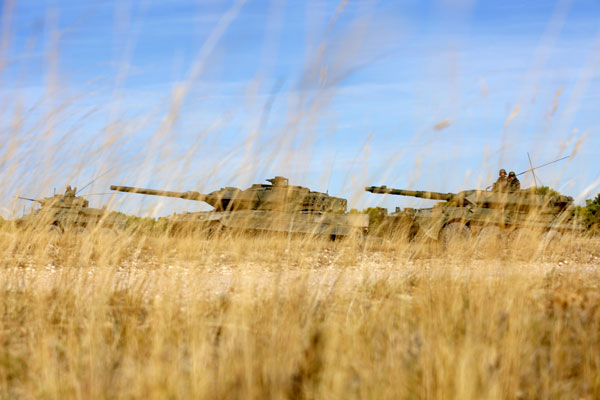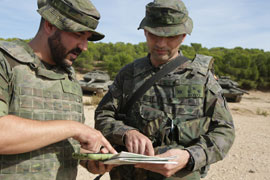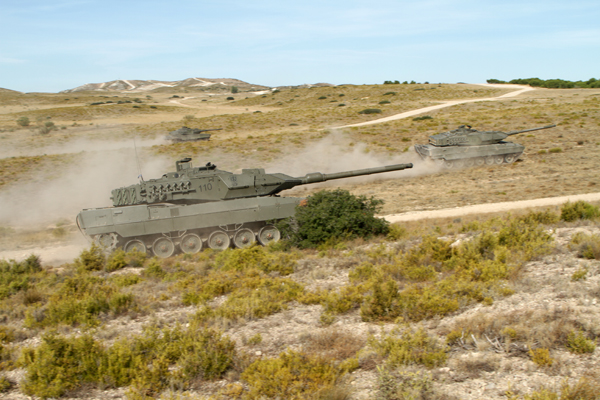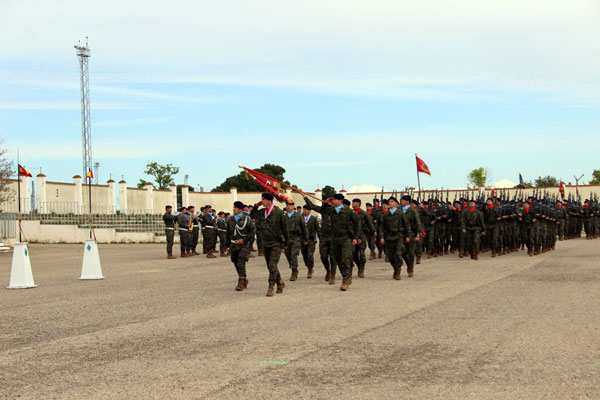- Home
- Feature Articles
- El nuevo 'Pavía'
The new 'Pavía'
Thursday, November 10, 2016
Number: 36
The armored Regiment, “Pavía” 4, is no longer just a Cavalry unit since the FLANDES, an Infantry Battalion, has been added to its structure.
The case of the ‘’Pavia’’ Regiment’s transformation is quite peculiar.
First of all, it now becomes “Armored Regiment” taking as starting Regiment, a Cavalry Regiment; which term ‘Cavalry’, disappears. To understand this change better, we need to know that an Infantry Battalion has been added to its organization. It is the ‘’Flandes’’ [Flanders]; a Light Infantry Battalion that belonged to the former ‘San Marcial’ Light Brigade.
Actually, after many years of absence (from 1985, year in which the Infantry Regiment ‘’Las Navas’’ 12 was disbanded), the Infantry Military personnel has come back to Zaragoza. Earlier this year, they were only 80 those who went to the Battalion from Vitoria (a century in garrison over there) to Zaragoza. Now, there are around 200 and, as companies become activated, the number will grow.
Many commands had to bring themselves up-to-date in the presence of the Leopardo

With the arrival of more, the unit will gain combat power

The Group and the Battalion share training activities related to the Leopardo
This conversion, that in writing seems settled, is very alive in its daily basis for Colonel Turiño. He had been in command of a Cavalry Regiment –displaying its ‘horseman’-like spirit− and which soldiers like to be called hussars. But now, in 2016, he is in command of a Regiment that has an Armored Cavalry Group (“Húsares de la Princesa”) and a Light Infantry Battalion (“Flandes”). This a dilemma similar to the one a father who has 2 children faces when comparing the two of them and “he cannot differentiate between children.” The new sibling has to feel equally loved than the older sibling. That is what the Regiment has been trying from the beginning, even though there are too many “spears” for just one Infantry Military. One only needs to go to the Regiment’s historical hall to see that Cavalry motifs prevail. However, this is going to change since room needs to be made in order to put the great amount of very valuable historical objects that the “Flandes” has been amassing in its 400 years of history. Similarly, the Infantry anthem or the Immaculate as saint patron are already symbols of the Regiment along with the Cavalry anthem or St. James.
This new situation has also created a mixed Regiment’s Senior Staff Command; that is, with a representation for the 2 combat arms. Even though, the Infantry military represents the minority (just 3), they feel in good company.
The NCO Piña, from the ‘’Extremadura’’ Brigade, says that he wouldn’t think of changing destination (except for the fact that it is quite far from his home) because he has seen the Battalion revive. He is very comfortable with his colleagues plus he masters the job at the S-4 [logistics] since the applications are the same to those with which he used to work in Badajoz. He even jokes saying that there is a spear on his uniform’s coat of arms.
Equally happy is private Quintanilla working at the S-1 [Human Resources]. He came from Vitoria and, although the work volume has increased in the last quarter, he does not complain at all. He says he feels useful and satisfied to have collaborated on something that is working.
Leopardo, the big star
The most substantial change, nonetheless, is the one stemming from its armored unit new condition and the arrival of the Leopards [los Leopardo in Spanish]. This material was not part of either the Group or the Battalion’s dotation, therefore, they had to get on with it to train heads of tanks and crews. The training has also been for the specialized in maintenance service and mechanics which are part of a 2nd common level for both units. These units are also made up of personnel with experience that help those who were not used to the tanks.

Leopardos tanks’ unit
In this adaptation to the Leopardo, the Cavalry Group is ahead since, as Lieutenant Colonel Vela puts it: “The Group and the Regiment’s tradition is armored, whereas their tank-like mindset is still present.” Nonetheless, in the last years, the hussars just have had CEV (Cavalry Exploration Vehicle) and the so called, Centauro, so they have to go from wheels to continuous tracks.
The change is even bigger for those who have always been in Light Infantry Units. That has been the case of Major Beneitez, Battalion’s Operations Chief. His main duty has been the training of tactical tanks’ jobs [chief, driver, and shooter-loader]. Thanks to this, in just few months, 8 crews are already trained and other 8 are on the way. He affirms that the training has been very demanding for the military personnel, but the outcome has been very positive. ‘’The trainees are highly motivated to put this new unit to work’’, he adds.

The red and blue colors are intertwined on the scarves showing the presence of the 2: Infantry and Cavalry
An example of enthusiasm is private Del Rio. Coming newly from the training Center, he arrived to the “Flandes” and started the shooting course. “I have never thought I had to study so hard in the Army”, he says.
After many theoretical and on-hand hours in the simulator, he can now show off as one of the first shooters of the Battalion and he can’t wait to participate in November in the first actual fire exercise of the unit. And, as it is usually said, to have a baptism by fire.
The "Flandes" Battalion is one of the units with the youngest personnel, in average, of the Spanish Army.
With such a troop, it is normal that NCOs like Sergeant De la Torre or Sergeant Araujo are delighted. Mr. De la Torre, one of the battalion’s seniors [almost 10 years over there] had to change his mindset to adapt himself to the APC (Armor Personnel Carrier) and be able to teach his guys. Ms. Araujo comes from the 12th Brigade and she acknowledges that many afternoons she finds herself reviewing manuals to avoid not knowing how to answer all the questions of a highly inquisitive troop.
Relaunching the “Flandes”
The excitement and devotion of this whole personnel, many of whom are of new admission and with an average of 25 years of age, have tremendously helped to the success of a complex relaunching of the ‘’Flandes.’’ First, moving to a different town -from Vitoria to Zaragoza-, which was translated into low stability of personnel (choosing destination as a preferment right, along with those who passed the test coming from training centers and academies) that slowly has gone to normal after a non-stop back and forth. Second, assuming and getting into the armored spirit takes its time. What the Flandes command, Lieutenant Colonel Valdes, truly wants now is to increase the effectiveness as soon as possible. He states that “a unit is not an academy although its main activity is training, but focused on effectiveness.” That will be achieved whenever the rest of the Leopardos keep arriving. It is the vehicle that defines them as future tanks Battalion (the one they have to become). Despite that transformation, the Battalion wants to keep alive the memory and the personality of a unit with 4 centuries of history.
Fewer squadrons
There is no doubt that for the “Flandes” the last months have been crucial. However, for the “Húsares de la Princesa” they have also been vital since they have reduced the number of squadrons. But, the biggest effort for them was, one, the simultaneous deployment of the Group into 2 international missions —Mali and Iraq—, and, two, the sum of the European Union Battle Group squadron for 2017. The chief of this Group is Captain Juan Martín, a senior of the Group —almost 8 years in the unit—. He is one of those who has best understood that now they are all on the same team. No wonder, his unit has support, such as mortars, coming from the Battalion.
And as the Pavia motto goes: “No matter how many the changes might be, the Regiment will be always fearless.”
ARMY UNITS
- Araba Álava |
- Albacete |
- Alicante |
- Almería |
- Asturias |
- Ávila |
- Badajoz |
- Barcelona |
- Burgos |
- Cáceres |
- Cádiz |
- Cantabria |
- Castellón |
- Ceuta |
- Ciudad Real |
- Córdoba |
- A Coruña |
- Cuenca |
- Girona |
- Granada |
- Guadalajara |
- Gipuzkoa |
- Huelva |
- Huesca |
- Islas Baleares |
- Jaén |
- León |
- Lleida |
- Lugo |
- Madrid |
- Málaga |
- Melilla |
- Murcia |
- Navarra |
- Ourense |
- Palencia |
- Las Palmas |
- Pontevedra |
- La Rioja |
- Salamanca |
- Segovia |
- Sevilla |
- Soria |
- Tarragona |
- Santa Cruz de Tenerife |
- Teruel |
- Toledo |
- Valencia |
- Valladolid |
- Bizkaia |
- Zamora |
- Zaragoza



